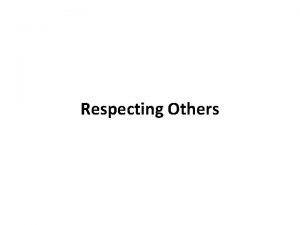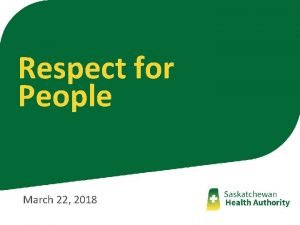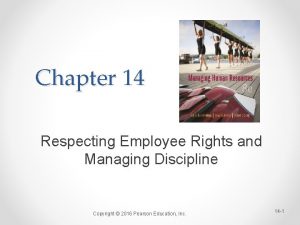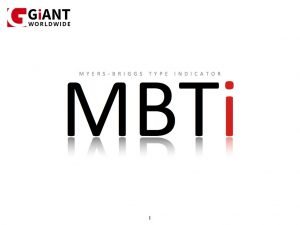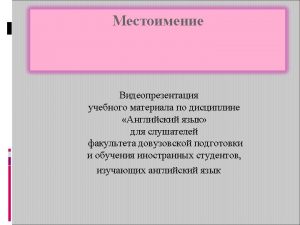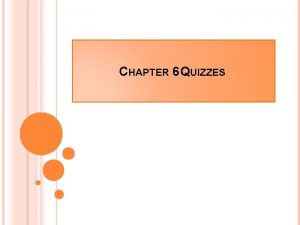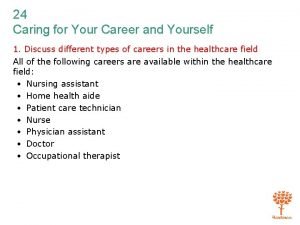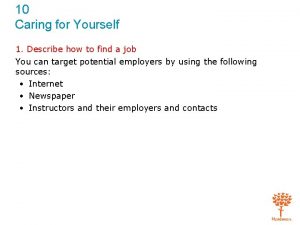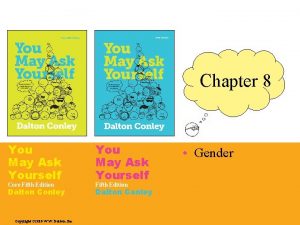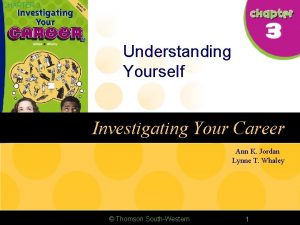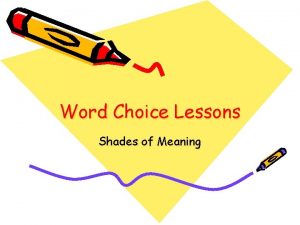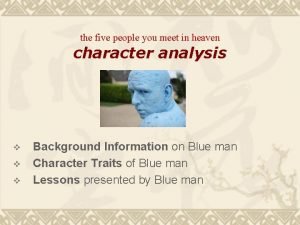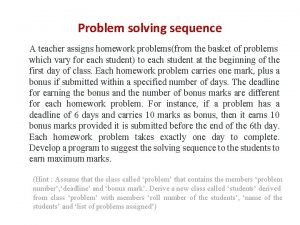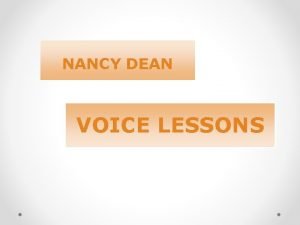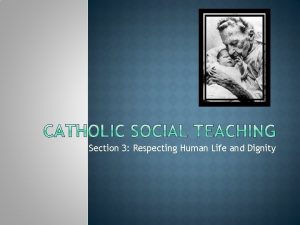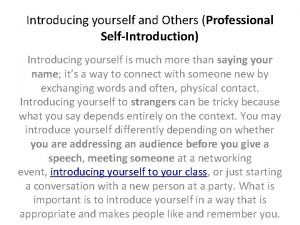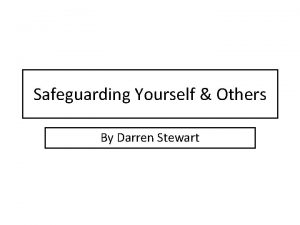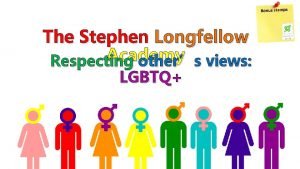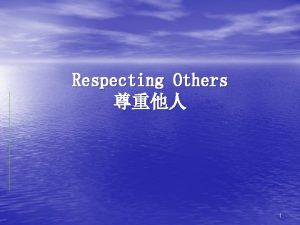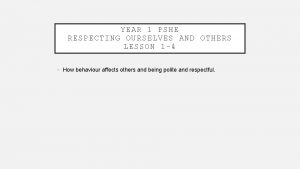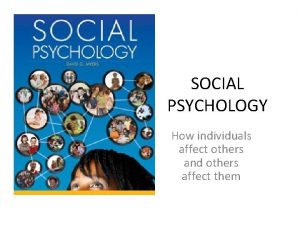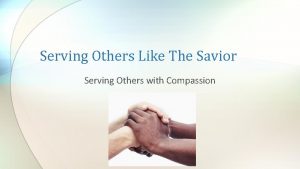Chapter 6 Lessons 2 3 Respecting Yourself Others




























- Slides: 28

Chapter 6 Lessons 2 & 3 Respecting Yourself & Others - Bullying, Discrimination, Prejudice, Sexual Orientation, & Sexual harassment - Communication

Do Now Write directions from Cherokee South parking lot to your house

Directions Map Communication- ways of sending and receiving messages 1) Verbal- speaking 2) Non-verbal- body language Communicating Styles 1) 2) 3) Passive- unable express thoughts Aggressive- try to get way through intimidation Assertive – express views clearly and respectfully To Communicate effectively you need to learn speaking skills, listening skills, and nonverbal communication.

SPEAKING SKILLS Types of Messages You messages – blaming or shaming express “You never let me do anything” I messages – healthful “I wish you could trust me enough to allow me to do things”


I MESSAGE I feel ______________(be specific) when you _________________ (give details of the behavior or circumstances) Because __________________ (this is the hard one: the "why")

Listening Skills Active Listening – pay close attention to what someone is saying and communicating TECHNIQUES Don’t Interrupt Show interest (eye contact, body language, remove distractions) Empathize Ask Questions

Non Verbal Body language – non verbal communication through gestures, facial expressions, behaviors, and posture Body language video - Start 32 – 1: 30 min Mixed Messages – verbal & non-verbal do not match

Active listening activity


Man on the left: 1. Hands are clasped and locked. He is defensive 2. Crossed legs. He is defensive. 3. Facial expression. He is not smiling and doesn’t look convinced. He is directly looking at the woman on the right who is his main concern. 4. Body orientation. His whole body is directly facing the woman on the right. He is confrontational with the woman Woman in the middle: 5. Gesturing. Heavy gesturing is used to justify a particular position. 6. Legs apart. Legs are not crossed and instead are apart. This suggests a threatening posture. 7. Direct eye contact with the woman on the right. Another confirmation of direct focus and an attack. Woman on the right: 8. Pointing to self. A classic defensive gesture justifying a position. 9. Legs are tightly closed. Suggests a defensive stance. 10. Direct eye contact. She is directly looking at the person who is attacking her to maintain focus.

Take out your Chapter 6 note sheets begin to answer the questions on the DO NOW side of the worksheet

Do you think bullying is a serious problem in your school or community? Why or why not? What can YOU do to prevent or stop bullying?

Bullying – harming or threatening other people who cannot defend themselves My kid wouldn’t bully Girls Boys 1 out of 4 students get bullied Types of Bullying: Physical, verbal, Cyberbullying, and hazing.

Battle at Kruger

Discrimination & Prejudice – unfair opinion or judgment of a particular group (Jackie Robinson ) (Ex: Racism) Discriminate – treating groups people differently (Ex: Title IX ) Hate crimes – crimes motivated by prejudice

Pyramid of Prejudice Extermination Physical Attacks Discrimination Avoidance Speech Examples from each

Extermination – physical attacks turn deadly Physical Attacks – expression of anger or resentment that has built from the first step (speech) Discrimination – Treating someone differently. Many different forms from denying a job to segregation Avoidance – avoiding the people that have been talked about and stereotyped Speech – talking or making fun of a group usually a result of stereotyping

"Never doubt that a small group of thoughtful, committed citizens can change the world; indeed, it is the only thing that ever has. " — Margaret Mead

Stop Discrimination & Prejudice No Stereotypes –exaggerated or oversimplified belief about group people - Interrupt behavior 1) 2) Show Empathy- share in others emotions 3) Avoid comments that discriminate 4) Learn about different people

Summarizer With the person sitting next to you, answer the 3 -2 -1 summarizer questions on the back of the page. Everyone turn in a copy at the end of the period.

FACTS Eighty-five percent of girls and seventy-five percent of boys surveyed say they have experienced unwanted and unwelcome sexual behavior that interferes with their lives. One-third of those students who have been harassed first experienced such unwelcome behavior before seventh grade. Studies indicate that there is a 75% chance that the harassment will continue or escalate if ignored.

Sexual Harassment ANY unwelcome verbal or physical advances or suggestions of a sexual nature. Non-touch In groups come up with examples Touching

Examples Sexual Harassment Sexual gestures Drawling or pictures sexual obscene Touches you & unwelcomed Comment sexual orientation Constantly invite you out

Flirting vs. Sexual Harassment Wanted Confident Feeling Complimentary Mutual or shared Non threatening Builds self-esteem Feels equal both parties Can be flattering • Unwanted • Feels bad • Is degrading • Is one sided • Is threatening • Builds up ego giver • One person power • Demeaning and insulting

Golden Rules Courtesy over contact – (handshake not a hug) Candid camera test – if a camera was on you would this action be appropriate Personal space Speak up – if your uncomfortable let the other person know http: //www. youtube. com/watch? v=eu. Xzk. LZQ PRY

Sexual orientation – is recognition of a gender preference with regard to sexual attraction - homosexual – attracted to people of same gender - heterosexual – attracted to people opposite gender - bisexual – attracted to both genders

? ‘s to answer 1) How would it feel to hide something as basic as your sexual orientation?
 Chapter 6 lesson 2 respecting yourself and others
Chapter 6 lesson 2 respecting yourself and others Objectives of respecting others
Objectives of respecting others Showing respect in the workplace
Showing respect in the workplace Respect objectives
Respect objectives Respecting employee rights and managing discipline
Respecting employee rights and managing discipline Motivating yourself and others
Motivating yourself and others Know yourself to lead yourself
Know yourself to lead yourself Check yourself before you wreck yourself origin
Check yourself before you wreck yourself origin Myself yourself
Myself yourself Ict in education images
Ict in education images Chapter 6 quiz 1 lessons 6-1 and 6-2 answers
Chapter 6 quiz 1 lessons 6-1 and 6-2 answers Chapter 31 caring for your career and yourself
Chapter 31 caring for your career and yourself Chapter 10 caring for yourself
Chapter 10 caring for yourself You may ask yourself chapter 8
You may ask yourself chapter 8 Chapter 24 caring for your career and yourself
Chapter 24 caring for your career and yourself Imagine yourself as a living house
Imagine yourself as a living house Word choice lessons
Word choice lessons 5 elements of voice
5 elements of voice Vex iq lessons
Vex iq lessons Tinkercad lessons for middle school
Tinkercad lessons for middle school Shunammite woman lesson
Shunammite woman lesson Great gatsby activities
Great gatsby activities The five people you meet in heaven lessons
The five people you meet in heaven lessons Plagues and egyptian gods chart
Plagues and egyptian gods chart Boleslavsky acting
Boleslavsky acting Python turtle lessons
Python turtle lessons The teacher assigns homework after 3/4 of the lessons
The teacher assigns homework after 3/4 of the lessons Outstanding pmld lessons
Outstanding pmld lessons Nancy dean voice lessons
Nancy dean voice lessons

